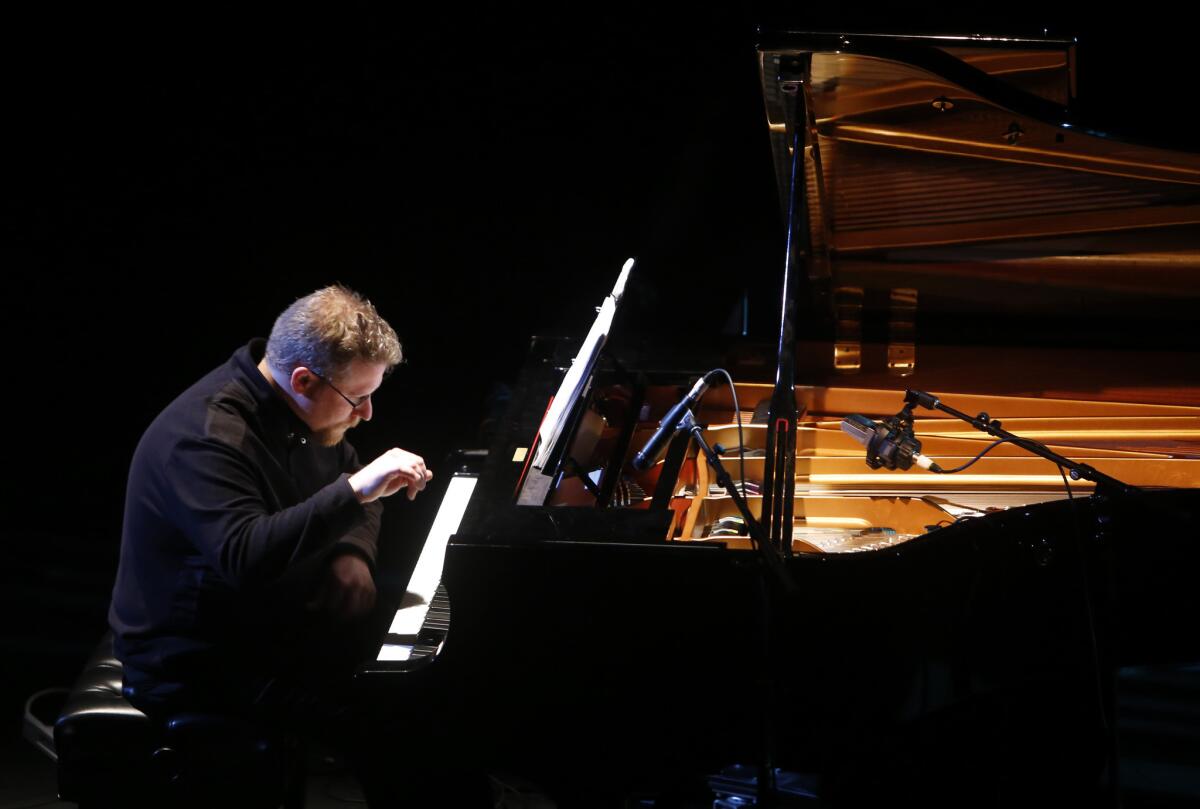Review: Aron Kallay experiments, triumphs in Piano Spheres’ ‘Nothing Is Real’

- Share via
Aron Kallay titled his premiere Piano Spheres recital at REDCAT on Tuesday night “Nothing Is Real.” May a reviewer beg to differ?
That is the title of the American experimental composer Alvin Lucier’s ethereal arrangement for piano, electronics and teapot of the Lennon-McCartney song “Strawberry Fields Forever.” It was written for Japanese pianist Aki Takahashi, and Kallay played it with the refined devotion a practitioner gives to the Japanese tea ceremony.
The song is first heard as airy fragments on the piano, which are recorded and then played back on a small speaker placed in the teapot. They sound distant when the pot is closed, more present when it is opened. Lucier turns the Beatles into music that can be poured.
In that sense nothing was real. In another sense reality was perhaps stretched but not defied. With the help of electronics, the piano keyboard became extended in several pieces. One player could become many. Notes between the keys could be heard.
But in all other senses, everything really was real in this outstanding recital. Kallay’s was the second program in Piano Spheres’ new satellite series this season at REDCAT devoted to young local pianists. The black box is smaller than Zipper Hall at the Colburn School across the street, where the four original members of this venturesome series perform their annual recitals. REDCAT benefits from intimacy, from the frisson of a full house and from the conviviality of the lobby bar.
Most important, though, is that the four younger L.A. pianists (Richard Valitutto was the first last month) are the next generation in what has become an L.A. tradition. The late Leonard Stein had formed Piano Spheres in 1994 for his students, creating a community of pianists with a flare for new music.
Kallay — who, like all Piano Sphere-ists, has a busy career in a multitude of freelance, teaching, recording and various chamber music activities — happens to have been a student of Vicki Ray, one of the series’ original pianists, and he also performs in a duo with her.
Along with the Lucier, Kallay included an otherworldly second work by a senior American avant-gardist. George Crumb’s “A Little Suite for Christmas, A.D. 1979” was inspired by Giotto Nativity frescos. This too is music with sounds that seem ancient, mysterious, from afar, but never unreal.
The heart of the program dealt with works by younger, more in-your-face composers, all of whom apply electronics. All, as well, reacted to natural phenomena in their music.
The impetus for Ian Dicke’s “White Parasol” was the melting of Arctic ice caused by global warming. Chords, helped by loud amplification, give the effect of breaking ice shards.
In Lithuanian composer Vykintas Baltakas’ “Pasaka,” Kallay madly barked a text that had something to do with creation myth. At the same time he violently attacked the keyboard. All of this was recorded and played back while new barking, vocal and pianistic, was added.
Pierre Jodlowski’s “Série Blanche” is a musical depiction of gray, snowy landscapes. It began with Kallay playing a simple line, which was recorded and played back in a loop. The counterpoint continued to grow as new layers were added, eventually building into a cathedral of sound.
Misty video imagery of said snowy landscapes were projected on a screen behind the pianist. They looked as ordinary as the music. But the piece kept building. The sounds of drums were added. Once the overloaded electronics reached a massive climax, we were left in someplace sonically new, full of electronic echoes and somber piano chords, as though arriving in a magically gray land.
Brian Shepard’s “All the Pretty Colours of the Rainbow” was played on an electric keyboard that could produce microtones. The composer, who is both percussionist and engineer, matched color frequencies with their sonic equivalents. But unlike the visual spectrum, the audio can have, until your ears adapt, the odd effect of making a listener feel queasy when pitches go astray. Shephard’s score became an absorbing exercise in adaptation and might even serve as a cure for seasickness.
In the last piece, Kate Moore’s “Bloodmoon October,” which was written for the concert, the Australian composer turned to the phenomenon of a red moon and produced a scintillating study in vibrating, rapidly repeated chords. Like everything on the program, it was dazzlingly played and easily held one’s interest.
For an encore, Kallay grabbed baseballs in each hand and attacked the keyboard and all the strings of the piano. Later he played with a mitt on. This was Annie Gosfield’s “Brooklyn, October 5, 1941,” a striking evocation of the Dodgers’ blowing a World Series game in the bottom of the ninth. What could be more real than that?
Twitter: @markswed
More to Read
The biggest entertainment stories
Get our big stories about Hollywood, film, television, music, arts, culture and more right in your inbox as soon as they publish.
You may occasionally receive promotional content from the Los Angeles Times.











